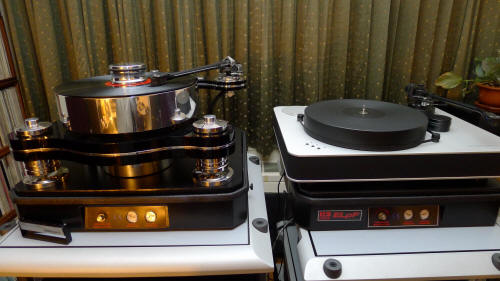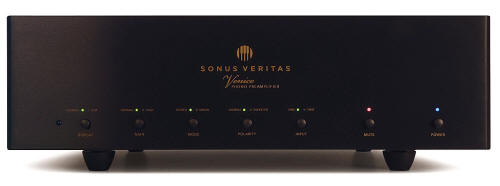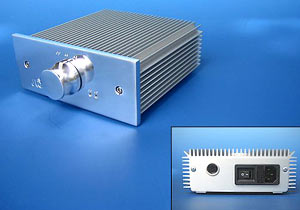|
|
You are reading the older HTML site
Positive Feedback ISSUE 61
transrotor Rondino Turntable as reviewed by Marshall Nack
As time passes and I progress ever upward in this hobby, it strikes me that one goes through stages. It begins casually enough and usually unnoticed, like an infection. A co-worker drops hints at the water cooler. Perhaps next time, he even invites you to check out his system. Afterwards, you find yourself daydreaming about gear. And then you take out a subscription to Stereophile magazine. That's it: you've got the bug. Some people are more susceptible than others and, as with most infections, recovery can be difficult. At the entry level, you can get an enticing taste of the possibilities, but you are still doing battle with functional and sound constrictions. I'm arbitrarily going to assign a price ceiling of up to $5K to turntables in this category, knowing there will be exceptions. At the mid-level, you enjoy a trouble-free, reasonable facsimile. The large, coarse-grained constrictions are taken care of. Generally, these are turntables priced up to $10K. At the high-end, the "reasonable facsimile" of the mid-level edges closer and closer to something that at peak moments gives glimpses of "fool-ya realism." The issues now are fine-grained, harder to isolate and even harder to resolve. Generally, these turntables cost beyond $10K
For the last year my reference turntable has been the Dr. Feickert Blackbird, a twin-motor, unsuspended German import. I enjoy its no-nonsense functionality, neutral voicing, excellent tone and timbre, and competent handling of dynamics. It's a strong contender in the middle category, the strongest I've yet auditioned. I commend it for your consideration, if that's your price point. (MSRP $8000, for table alone.) Cosmetics Visually, the newly introduced Transrotor Rondino couldn't be more different than the Blackbird. (MSRP for Rondino without arm is $14K.)
Put them side-by-side and you'll see two completely different design aesthetics at work.
Taking pictures of the sleek and stylish Rondino is easy. Its high-tech glamour and sculptural, curvy lines have obvious eye appeal. Mine came in an attention-grabbing black acrylic and polished aluminum color scheme, called the Rondino Nero. Well, attractive to me, at any rate. It was curious, how people divided up: They either admired its looks or were put off, with no neutral ground. Those that liked it commented on its eye-candy appeal. "For that kind of money, you should get something that doesn't recede into the background." Fit-n-finish is indeed very high quality. For the others, there were comments about there being too much machinery on view or, "Why so much gleaming aluminum?" Of course, there are reasons for all the machinery, which we'll get to later in the technical overview. First Impression Given their radically divergent visuals, I was initially quite surprised at how similar they sound, observing from a coarse-grained vantage point. Tonal balance, timbre and soundstaging are approximately the same. I didn't have to tweak at all for the new table. Nonetheless, I don't think you could ask for a better illustration of the difference between mid- and high-end categories. The dead giveaway is how much work is needed to comprehend what each table reproduces. With the Rondino, understanding the action on the stage and which instruments are playing at any given time is nearly effortless. With the Blackbird, it sometimes requires a little work. I determined pretty quickly that the leap in playback quality is exactly those fine-grained differences that fall into the area of noise-byproducts.
For source material, I started with two mint, plum label, 1S copies of the golden era Victrola LP, VICS-1199, with Reiner and the Chicago performing Ravel's Valses Nobles Et Sentimentales. Noise is the Culprit In audiophile jargon, we talk about noise as a persistent, low-level artifact unrelated to the musical signal, lurking in the background. We talk about a components noise floor. When it is especially quiet, we say it has a "black background."
Good enough. Both of these tables have admirably low noise floors. However, there are other kinds of noise. In quick A/B comparisons, you will notice a roughness in the Blackbird's transient plus a spray of unrelated tonal particles around it, which makes the leading edge blurry. Then, following the transient there is an undifferentiated white noise that rides along with the note. It is unrelated to the sound of the instrument(s), although it sounds like it might be from them: when the signal stops, it stops. These two kinds of noise are not in the grooves, because they're not present with the Rondino. The Blackbird creates them. It is present in all bands and especially when signal strength is high. It is a noise that I never suspected in the Blackbird. (Isn't that always the case?) Keep in mind that the Blackbird has been my reference for low-noise, high-res up until now. And note: The Blackbird sample I'm using does not incorporate the latest upgrades, trickle down from the more ambitious Firebird model. I'm told current Blackbirds with these upgrades knock on the door of the third category. Noise of this sort is present to some degree in every turntable, but you never gain perspective on it until you hear it done differently. I remember the first time it came to my attention back when I owned a Linn LP12 and I was during a similar comparison. Only after I compared the LP12 to the VYGER Baltic M did I notice a pervasive noise in its playback. This type of revelation is always a shock. The noise manifests itself in the treble, which sometimes can be raucous, at other times hard. In either case, it sounds different than the treble should. In the bass and midrange, the tonal center can become ambiguous and string tone loses its lustre. Needless to say, this noise obfuscates everything to a degree, making it difficult to positively ID who's playing.
Impact Do these "symptoms" sound familiar? If I spin the wording a little differently, it might help you recognize them. If you've been playing tables in the first or second category, you might interpret the spray around the transient as air or bloom; the clangorous treble as bite; the rumbling bass as powerful, "knock-your-socks-off," dynamics. The Rondino will have none of it: It has less noise than any table I've auditioned. At this point, I consider the Rondino the leader at noise avoidance. Voicing The other difference between the tables is a matter of voicing. The Blackbird subscribes to classic analog voicingPartly, this is defined by an exciting transient, enhanced body and bloom, and powerful but warm bass. If we were talking about amplification, I would throw in an injection of second-order harmonics. These are classic vinyl artifacts that many of us have grown used to hearing, even become fond of. Take them away and owners of these tables are likely to say, "Where's my music?" Again, the Rondino will have none of it. The Rondino throws a crystalline landscape, peppered with the images of the instruments at play, as pure as a Baccarat crystal vase, as transparent as you're likely to hear. Stage depth is exquisitely developed while width is similar to the Blackbird. Images are where you expect them to be and proportionally sized. The stage has such integrity that you can isolate individuals within a group, even if they are layered on top of each other. All are rendered with utmost fidelity to the source. You can "see" the true onset and character of the note. I don't hear the Rondino adding anything It's so pristine and ultra refined, the question passed through my mind—is it subtractive? Tics and pops are decidedly reduced. That begs the question, what else may be missing? I don't hear anything missing. There's just enough of everything. How does a table do that? It's all in the engineering: how the designer solves the problems of spinning a disc and retrieving the info. We'll get to the innovative approach employed in the Rodino in a bit. I think analog designers who subscribe to the contemporary voicing have been paying attention to developments in digital, especially hi-res digital. (I also think digital engineers have been listening carefully to analog.) Their products commingle the virtues of the two; consequently, they are coming to sound more alike. A classically voiced analog table, on the other hand, doesn't sound remotely like digital. And, just as there was no middle ground on appearance, people also divided up on sound. There are those who want analog to sound like it always has—actually, there are a lot of people in this camp—and those who don't care about where we came from; they just want it to be more realistic. Admittedly, you need a highly resolving system to appreciate the impact of these differences. Ideally, it should be at the same level as the Rondino or better. You would also be advised to steer clear of analytical phono stages. In this regard, I'm fortunate to have the Sonus Veritas Venice at my disposal, a pacesetting phono stage at a level that facilitated these observations. I love it when components force you to step out of your comfort zone, to think hard about something you're hearing that doesn't fit the usual paradigms. A Sweet Sound You might get the idea from the preceding copy that the Rondino is a lean and mean machine but that's not quite true. It is certainly clean and pure sounding. That means it won't beef up thin-sounding LPs and any flaws will be heard clearly. However, as a member of my listening panel likes to say, cleanliness is a sweetness all its own. Ergo, the Rondino is actually one very sweet sounding turntable. BUT, the sweetness is not coloration. It comes from the removal of noise. The Rondino is straight-up neutral. Dynamics Micro dynamics are particularly fine. The Rondino gets really soft, softer than any table I can recall. Then it builds gradually to a dynamic peak in a smooth and finely graded progression. There's no excess in terms of body, timbre or hall effects. Again, there's nothing coarse or abrupt. At the same time, the Rondino is blazing fast. That's key: it moves like a nimble roadster, but smoothly and without showing off. Setup Since the Rondino came without an arm, I managed to borrow an SME 312. The Blackbird has a 12", S-shaped DFA-12.0 tonearm. (The importers approved both combos.) I outrigged both with Shelter Harmony cartridges and identical K-S arm cables, power cords and ICs, which fed into the Sonus Veritas Venice phono stage.
The Venice has two inputs selectable from the front panel or its remote, making it ideal for these kinds of comparisons. The tables sat on ELpF Vibraplane platforms on identical racks. In short, I made every effort to have parallel setups, reducing the variables to just table and arm combos. Assembly It wasn't hard to setup the Rondino, once you figure out what needs to be done. The brief installation manual has problems. First, there's got to be a parts diagram and inventory. Second, two instructions were dead wrong. For example, on page four, "Take care that the distance between drive unit and main bearing is not bigger than 3 mm." I did that and the table promptly locked up. It should say, "…is not less than 3 mm."
The platter is massive, if not high mass. It is 2 ¾" tall, but weighs only 20 lbs. (Total turntable weight is 55 lbs.) It is hollow inside and specially grooved to be anti-resonant. The plinth is a three-layer, constrained design comprised of acrylic and aluminum. The Rondino uses a KM-1 motor control identical to the one supplied with the Fat Bob S turntable I reviewed a while ago. Speeds of 33⅓ and 45 can be selected with the flick of a dial. When it starts up, the platter likes an assist to get up to speed. Once there, it is as steady as a rock. Engineering Aspects The Rondino has several innovative design concepts:
Conclusion The newly introduced Transrotor Rondino is sleek and stylish. Its sculptural, curvy appearance will appeal to many. In sharp contrast to how it looks, its sound is the ultimate in sophistication. Everything you need to hear is there—nothing more, nothing less—and no single thing is highlighted to disrupt its balanced presentation. It is a fine example of a major trend in contemporary analog emerging over the last decade or so. The goal is an uncompromised reproduction of acoustic instruments in real space. Partisans of this branch of analog discard the classic signature of analog and also pay attention to advances in digital (and digital does likewise). Consequently, the two sources are sounding more alike. (And more like reality, in my opinion.) Classically voiced analog retains attractive colorations from the early days of vinyl and doesn't sound remotely like a digital front-end. Each branch of analog voicing has legions of fans. In addition, the Rondino is the quietest turntable I've encountered. More than having a black background, it reduces forms of noise I didn't know were there until they weren't. Innovative engineering solutions account for the removal of this noise and what I call "filler tone." When the source is good, the Rondino delivers extremely high credibility. Its voicing is especially good for classical music. I give it an A+ rating and recommend it most highly for your consideration. Marshall Nack
Rondino turntable (w/o arm)
Transrotor Importer
Axiss Distribution, Inc.
|











